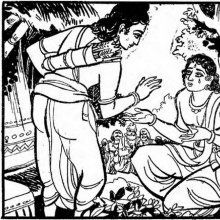Pine, Pimte: 3 definitions
Introduction:
Pine means something in the history of ancient India, biology. If you want to know the exact meaning, history, etymology or English translation of this term then check out the descriptions on this page. Add your comment or reference to a book if you want to contribute to this summary article.
Images (photo gallery)
India history and geography
Source: Shodhganga: Deforestation in Nagaland: a historical perspectivePine is the name of a plant corresponding to Pinus khasiya, according to the author Lanukumla Ao in his thesis “Deforestation in Nagaland”, mentioning the source: Annual Administrative Report 2012-2013.

The history of India traces the identification of countries, villages, towns and other regions of India, as well as mythology, zoology, royal dynasties, rulers, tribes, local festivities and traditions and regional languages. Ancient India enjoyed religious freedom and encourages the path of Dharma, a concept common to Buddhism, Hinduism, and Jainism.
Biology (plants and animals)
Source: Google Books: CRC World Dictionary (Regional names)1) Pine in India is the name of a plant defined with Calophyllum inophyllum in various botanical sources. This page contains potential references in Ayurveda, modern medicine, and other folk traditions or local practices It has the synonym Calophyllum calaba Jacq. (among others).
2) Pine is also identified with Vateria indica It has the synonym Vateria indica C.F. Gaertn. (etc.).
Example references for further research on medicinal uses or toxicity (see latin names for full list):
· Suppl. Carp. (1805)
· Encycl. (Lamarck) (1785)
· Isis (1828)
· Tetrahedron Letters (5909)
· Mag. Neuesten Entdeck. Gesammten Naturk. Ges. Naturf. Freunde Berlin (1811)
· Tetrahedron
If you are looking for specific details regarding Pine, for example pregnancy safety, side effects, diet and recipes, health benefits, extract dosage, chemical composition, have a look at these references.

This sections includes definitions from the five kingdoms of living things: Animals, Plants, Fungi, Protists and Monera. It will include both the official binomial nomenclature (scientific names usually in Latin) as well as regional spellings and variants.
Languages of India and abroad
Kannada-English dictionary
Source: Alar: Kannada-English corpusPiṃte (ಪಿಂತೆ):—[noun] = ಪಿಂತು - [pimtu -] 1.
--- OR ---
Piṃte (ಪಿಂತೆ):—
1) [adverb] at the back; coming or going behind (another).
2) [adverb] (with regard to time) in the past.
3) [adverb] in the absence of or indirectly.
4) [adverb] ಪಿಂತಾಗು [pimtagu] pintāgu to be overtaken by another (as in a competition); 2. to be left behind; to be passed by.
Kannada is a Dravidian language (as opposed to the Indo-European language family) mainly spoken in the southwestern region of India.
See also (Relevant definitions)
Starts with (+11): Pine geranium, Pine hyacinth, Pine maguey, Pine mountain coral tree, Pine thistle, Pine-mat manzanita, Pine-scented geranium, Pine-weed, Pine-woods clematis, Pineapple, Pineapple flower, Pineapple lily, Pineapple weed, Pineappleshrub, Pineappleweed, Pinedrops, Pinekai, Pineland milkberry, Pinem, Pinemat manzanita.
Ends with (+9): African fern pine, Alaskan pine, Amboina pine, Athel pine, Australian pine, Black pine, Ceylon screwpine, Coastal screw pine, Dally pine, Deodar pine, False lupine, Festoon pine, Fragrant screw pine, Fragrant screwpine, Furcate screwpine, Kauri pine, Khinpine, Lepine, Malabar white pine, Milky pine.
Full-text (+391): Devadaru, Sarala, Ketaki, Pitadaru, Kilima, Daru, Kshirahva, Shikara, Ananasa, Drukilima, Suradruma, Khantavanem, Suradaru, Mahadaru, Devakashtha, Paribhadra, Bhadradaru, Sharalaka, Varacandana, Jhuranem.
Relevant text
Search found 78 books and stories containing Pine, Pimte, Piṃte, Pinte; (plurals include: Pines, Pimtes, Piṃtes, Pintes). You can also click to the full overview containing English textual excerpts. Below are direct links for the most relevant articles:
Tiruvaymoli (Thiruvaimozhi): English translation (by S. Satyamurthi Ayyangar)
Pasuram 2.1.8 < [Section 1 - First Tiruvaymoli (Vayum tirai)]
Pasuram 4.2.2 < [Section 2 - Second Tiruvaymoli (Palan ay, El ulaku untu)]
Pasuram 4.2.3 < [Section 2 - Second Tiruvaymoli (Palan ay, El ulaku untu)]
A History of Indian Philosophy Volume 1 (by Surendranath Dasgupta)
Part 15 - Sautrāntika theory of Inference < [Chapter V - Buddhist Philosophy]
Part 17 - Inference (anumāna) < [Chapter VIII - The Nyāya-Vaiśeṣika Philosophy]
Part 19 - Negation in Nyāya-Vaiśeṣika < [Chapter VIII - The Nyāya-Vaiśeṣika Philosophy]
Ten Little Vignettes < [August 1948]
The Lonesome Pine < [December 1944]
The Mirrors < [January – March, 1990]
The Chaldean account of Genesis (by George Smith)
Kavyamimamsa of Rajasekhara (Study) (by Debabrata Barai)
Part 8.7 - The region of Uttarāpatha (northern part) < [Chapter 5 - Analyasis and Interpretations of the Kāvyamīmāṃsā]
Manusmriti with the Commentary of Medhatithi (by Ganganatha Jha)
Verse 10.101 < [Section XIII - The Brāhmaṇa in Times of Distress]
Verse 7.134 < [Section XI - Customs-Duties]
Verse 4.34 < [Section VIII - Duties of the Accomplished Student: Sources of Wealth]
Related products



